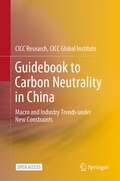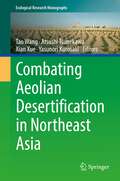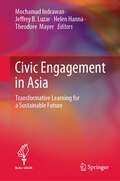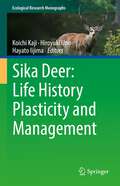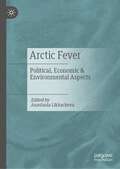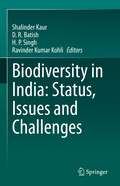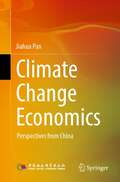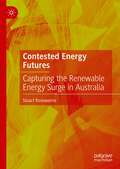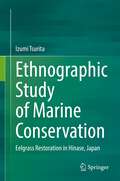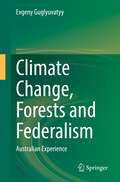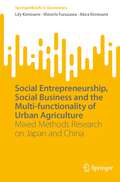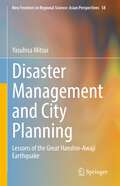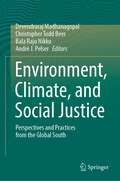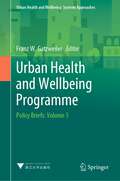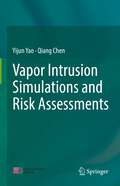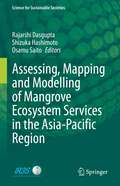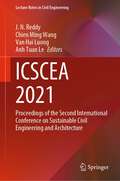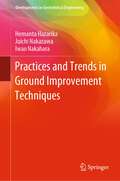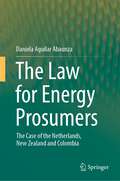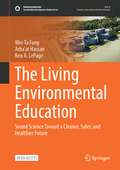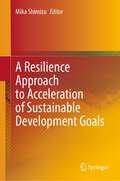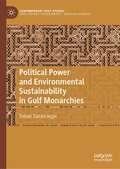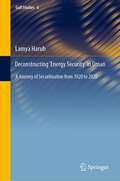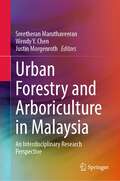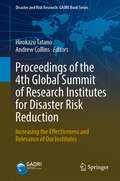- Table View
- List View
Guidebook to Carbon Neutrality in China: Macro and Industry Trends under New Constraints
by CICC ResearchThis Open Access publication focuses on China’s goal of achieving peak carbon emissions in 2030 and carbon neutrality by 2060. The book is the first to systematically build a framework combining a top-down and bottom-up analysis of this acute topic.What does carbon neutrality mean for economics in China? Might it imply stagflation or is it an opportunity to maximize the potential of green manufacturing?The book offers a comprehensive analysis of how the pursuit of carbon neutrality may influence the development of China's economy, and the country's biggest industries, while foreseeing the likely changes in people's lifestyles.In total, the book constructs a comprehensive path for China's carbon neutrality drive from the perspective of the green premium. This effort lays the foundation for a discussion of the country's emissions reduction plan.The book goes further, calculating the investment required for different sectors to achieve carbon neutrality, andillustrating the roles of carbon pricing and green finance in this undertaking.The book’s information comes from a network of primary sources, including experts in the field and noted academics, to depict potential low-carbon roadmaps and green transitions in major industries.Emphasized is green development in sectors that will be critical to civilization, including in technology, energy, manufacturing, transportation, and urban planning, which are backed by in-depth discussions and analyses.Accessible and academically rigorous, the work is anchored in the economics of carbon neutrality, extends to potential policy implications and identifies investment opportunities.This valuable reference will attract readers interested in public policy, economics, finance, and investors who seek to better understand China's prospects in the low-carbon economy of the near future.
Combating Aeolian Desertification in Northeast Asia (Ecological Research Monographs)
by Tao Wang Atsushi Tsunekawa Xian Xue Yasunori KurosakiThis book presents the definition of aeolian desertification and uncovers its processes, driving factors, and consequences, and focuses on measures to effectively combat aeolian desertification in Northeast Asia. Aeolian desertification in Northeast Asia is of great concern for its destructive influences on the environment and society not only in the local but also in faraway areas. The topics of this book are addressed by compiling theoretical review, remote sensing monitoring, synoptic analysis, and laboratory and field studies in China, Japan, and Mongolia. This is the first comprehensive book to address the aeolian desertification in Northeast Asia. Readers can learn the basic theory of aeolian desertification and the primary causes of this environmental problem. More critical is the successful practical countermeasures to combat desertification which can be referred to by various stakeholders who concern the aeolian desertification in Northeast Asia. To meet the Sustainable Development Goals of the United Nations adopted in 2015, especially its Goal 15.3 to achieve a land degradation-neutral world by 2030, desertification combating actions should be taken cross country borders. This book is not only intended for environmental professionals but also for people who are affected and concerned about desertification and land degradation. The concept and processes in this book will serve as a ready reference to understand the aeolian desertification with countermeasures and successful preventing stories that can be referred to.
Civic Engagement in Asia: Transformative Learning for a Sustainable Future
by Mochamad Indrawan Jeffrey B. Luzar Helen Hanna Theodore MayerThis book confronts issues relating to climate change and sustainable development innovations in Asia, with attention to key issues and applications in terms of advocacy, governance, citizen science, tradition, faith, leadership, and education. With contributions by 31 leading thinkers from countries in Asia, the book presents issues and poses potential solutions for sustainable development, responding to questions relating to problems prioritized by non-state actors for civic engagement. It also puts forward key strategies and methods used for civic engagement. Drawing from diverse sets of practical and scholarly experience and expertise in geographical and social arenas, authors draw from real-time engagement with specific peoples, often associated with civil society organizations, and conduct an exploration of the essential issue of what the world means in the context of different cultures, thus constructively fusing the two key themes of ecology and anthropology. In doing so, this book enables new ways of thinking about human relationships with nature, relating rich and diverse examples of transformative learning. Co-published with Indonesian press OBOR, this is a vital collection for practitioners and researchers working in areas of ecology, sustainable development, human ecology, governance, geography, environmental science and post-neoliberal economics, particularly in an Asian context. "Civic Engagement in Asia weaves together a set of fascinating stories and examples of sustainable development practice told from the perspectives of non-state actors. Written by a set of top scholars and activists from around the region, it will be an informative read for all those who feel a sense of urgency around the environmental, social, and economic transformations taking place across Asia today” - Celia Lowe, Professor of Anthropology and International Studies, University of Washington, Seattle
Sika Deer: Life History Plasticity and Management (Ecological Research Monographs)
by Koichi Kaji Hiroyuki Uno Hayato IijimaThis book provides complete and up-to-date information on sika deer biology and its management, focusing on their life history with an integrated approach of population dynamics, morphology, genetics, and evolution. The expanding distribution of sika and its increase in population in Japan and other countries are causing damage to agriculture and forestry, impacting ecosystems and affecting other species. We are facing conflicting deer issues regarding the conservation of resource values and pest control of sika deer. This contributed volume compiles new findings focusing on the ecological plasticity of the sika deer. It aims to clarify the ecological characteristics of the deer by integrating studies of different approaches and provides a perspective for their management. The book consists of six parts. Part I introduces the ecological and management background behind the history of sika deer. The following four parts discuss movement ecology (Part II), impact on vegetation and bottom-up effect on sika deer (Part III), impact on ecosystem and its resilience (Part IV), and comparison of life-history characteristics between sika deer and other ungulate species (Part V). The last part (Part VI) covers the science-based management of sika deer. Contributed by recognized experts and young researchers of sika deer, this book appeals to researchers and professionals in wildlife biology and wildlife management, evolution, population dynamics, morphology, genetics, and reproductive physiology.
Arctic Fever: Political, Economic & Environmental Aspects
by Anastasia LikhachevaThis book explores the Arctic as a rapidly evolving phenomenon in international affairs of a rising number of stakeholders. For decades, Arctic studies used to be an affair of a relatively narrow group of experts from northern countries. This time is over due to a new Chinese Arctic policy, as well as growing regional interests from South Korea, Singapore, India and Japan. Contributors reflect on new roles for the Arctic region: both as a playground for the old school nation state competition and even confrontation, and a new source for international cooperation in energy, logistics and natural sciences. Climate change, political tensions and economic competition make Arctic a hotter venue of international relations. This new Arctic fever, studied through a comparative analysis of different regional agendas, especially with a focus on the US–China–Russia triangle, represents the main subject of our book, which will be of interest to scholars of geopolitics, of climate change, and of 21st century energy economics.
Biodiversity in India: Status, Issues and Challenges
by Shalinder Kaur D. R. Batish H. P. Singh Ravinder Kumar KohliThis contributed book is based on the current status of biodiversity in India, issues and challenges faced by the authorities involved in conservation efforts, and the imperative role of various direct and indirect stakeholders in biodiversity conservation. The book discusses the current status of different forms of biodiversity in India, challenges faced by stakeholders, issues and reasons for biodiversity losses, and efforts by government through various laws, policies, and programs in a concise and comprehensive manner throughout its many chapters. In this way, readers can access diverse information on Indian biodiversity through this book. It is compiled by leading experts in the field of conservation. In 18 chapters, it covers biodiversity of both fauna and flora, on land and in aquatic ecosystems, legal and policy aspects, as well as innovative conservation tool and techniques. It is useful for undergraduates and graduate students and also educates policy planners, bureaucrats, foresters, and researchers in India and abroad.
Climate Change Economics: Perspectives from China
by Jiahua PanThis book establishes theories and methods of climate change economics based on the perspective of human development. The book, in two volumes, consists of papers and research reports authored by Pan Jiahua or researchers under his guidance. Professor Pan Jiahua is a leading figure in the field of political economy in climate change and has written extensively. The book is divided into four parts, covering theories, methods, governance, and policies. • The theory part includes the general economics of climate change, the political economy of climate change, carbon emissions, and human development. • The method part covers the economic analysis of greenhouse gas reduction and economics of low-carbon economic development. • The governance is on the design and construction of international climate regimes and China's role and choice. • Finally, the policy part consists of three chapters: policy choices for low-carbon transformation, energy-saving emission reduction, and low-carbon development and adaptation to climate change. The disciplines involved in climate change economics include welfare economics, development economics, international political economics, and property rights economics. In the context of multidisciplinary cross-cutting, the economics of climate change has evolved. The book proposes theories, methods and offers policy solutions and cases. It is of high academic and empirical value for developing countries to strive for fair rights and interests in international climate negotiations, obtain development space, and pursue a low-carbon and ecological economy. Professor Jiahua Pan and his team at the Chinese Academy of Social Sciences have contributed greatly to the development of climate change economics in China. Their work has laid the foundation of climate change economics from basic concepts, frameworks, and systems and has a great significance in promoting the development of climate change economics.
Contested Energy Futures: Capturing the Renewable Energy Surge in Australia
by Stuart RosewarneThis book unpacks the politics of climate change in Australia in the context of successive conservative Coalition governments resisting any moves to mitigate emissions and as local communities and transnational corporations struggle with each other to control the transition to a sustainable energy future. As Australia has abundant clean energy resources in terms of solar and wind, the book offers a test case for study of the energy policy transition in the 21st century. It does so by using tools from political economy and sociology, teasing out public attitudes to renewable energy technologies and innovative infrastructure investments, unpacking the complex parameters of this historical debate, tracing the rise of household 'prosumers' and arguing the case for grassroots ownership of renewable infrastructure or 'energy sovereignty' - already pioneered by some isolated communities in Australia. The cultural and emancipatory benefits of cooperative ventures are well known. However, capitalism is not readily defeated by democracy. The promotion of individual households as 'virtual power stations', of 'smart technologies' and even of cryptocurrency into the energy transition innovative mix opens up ever new horizons for corporate control.
Ethnographic Study of Marine Conservation: Eelgrass Restoration in Hinase, Japan
by Izumi TsuritaThis book explores the nature of marine conservation based on the case study of Hinase, a fishing village in Okayama, Japan. It focuses on the fishers’ self-motivated eelgrass restoration activity which has been continued for more than 30 years. This activity in Hinase recently attracted international attention as a case under the name “Satoumi” and “Marine Protected Areas” in several governmental reports, but detailed information, such as the historical background and social structure of Hinase, has not yet been analyzed. This book, therefore, fulfills this gap by providing its ethnographic information. In addition, this book offers some points for critical thinking by concluding that marine conservation activities cannot always be evaluated or arranged under the standardized approach with limited time and space. This viewpoint reaffirms the importance of local initiative and highlights the value of qualitative research to seek the way forward for promising marine conservation. This book is suitable for an academic audience in the field of social sciences, such as applied anthropology, as well as ecologists, government officials, environmentalists, and citizens who are interested or engaged in environmental issues or natural resource management.
Climate Change, Forests and Federalism: Australian Experience
by Evgeny GuglyuvatyyClimate change is one of the most serious global challenges facing humankind. Climate change has enormous environmental and economic implications, and finding a solution is a daunting task. The purpose of this book is to look at the global problem of climate change through the prism of an individual country's attempt to tackle this problem.This book begins with a discussion of the origins of climate change and the evolution of the international response to climate change. Key climate change mitigation actions and policies are considered to provide the necessary framework for analysing Australia's approach to climate change. Australia's climate change policy development is considered from a historical perspective. The book traces the evolution of the response to climate change, focusing on Australia as one of the Federal countries unable to adequately reduce greenhouse gas emissions due to the systematic failure of the Australian government to develop a common and effective approach to the problem of climate change. The book will be of interest to scholars and students of environmental law and the contemporary International and Australian climate change law.
Social Entrepreneurship, Social Business and the Multi-functionality of Urban Agriculture: Mixed Methods Research on Japan and China (SpringerBriefs in Economics)
by Lily Kiminami Shinichi Furuzawa Akira KiminamiThis is the first book to clarify the relationships between multi-functions of urban agriculture, creative classes, and social business in China and Japan. Specifically, it constructs a new framework showing how these factors contribute to the sustainability of cities by introducing the mixed methods research of structural equation modeling and the trajectory equifinality model. Policy implications drawn from the research suggests that governments should provide opportunities to create a virtuous cycle to improve the accumulation of social capital in order to attract those who think creatively. It is widely agreed that a sustainable city should meet the needs of the present generation without sacrificing the ability of future generations to meet their own needs. However, there has been no completely agreed-upon definition for what a sustainable city should be nor upon the paradigm for what components should be included. On the other hand, there is a possibility that the multi-functions of urban agriculture may attract especially those who are thinking creatively. These creative thinkers have a high level of social capital, pay attention to social issues, and are greatly motivated to find solutions through social enterprises such as agriculture-related business.
Disaster Management and City Planning: Lessons of the Great Hanshin-Awaji Earthquake (New Frontiers in Regional Science: Asian Perspectives #58)
by Yasuhisa MitsuiThis book first provides a comprehensive guideline for future disaster-resistant city planning in large cities in disaster-prone countries such as Japan. It is a compilation of knowledge and know-how obtained through the author’s work in the national government for one and half years in the Earthquake Reconstruction Headquarters, right after the Great Hanshin-Awaji Earthquake on 17 January 1995. The author has carefully examined the various ad hoc measures taken just after the earthquake, which were criticized because they did not work as well as expected. Additionally, he has examined the later revisions in disaster and risk management systems made at the levels of local and national governments through experience in the Hanshin-Awaji Earthquake, to which the author had long been committed. The author argues that the rescue activities, rehabilitation, and reconstruction plans for disaster countermeasures implemented once a disaster has occurred and the city planning established in ordinary times should be extremely tightly connected with each other. City planning that subsumes rescue activities, rehabilitation, and reconstruction plans against what ought to have happened would critically improve the capability of crisis management and, consequently, protect life and property once a disaster has occurred. Such city planning eventually creates disaster-resistant cities. This book assumes readers to be graduate students who study city planning. It is also beneficial for practitioners and policy makers who are in charge of the construction of disaster-resistant cities at the national and local levels of governments, especially in disaster-prone countries.
Environment, Climate, and Social Justice: Perspectives and Practices from the Global South
by Devendraraj Madhanagopal Christopher Todd Beer Bala Raju Nikku André J. PelserThis book approaches environmental, climate, and social justice comprehensively and interlinked. The contributors, predominantly from the Global South and have lived experiences, challenge the eurocentrism that dominates knowledge production and discourses on environmental and climate [in] justices. The collection of works balances theoretical, empirical, and practical aspects to address environmental and climate justice challenges through the lens of social justice. This book gives voice to scholars of the Global South and uses an interdisciplinary approach to show the complexity of the problem and the opportunities for solutions, making this book a powerful resource in teaching, research, and advocacy efforts. The innovativeness of this approach stems from the use of narratives, scientific explanation, and thematic analysis to present the arguments in each chapter of this edited book. Overall, each chapter of this book acts as a powerful resource in teaching, research, and advocacy efforts. This book fills a gap in the Global South production of environmental, climate, and social justice. It provides in-depth knowledge to the readers and raises their critical thinking about key elements/discussions of justice issues of environmental conflicts and climate change. The book is a useful read to a general audience interested in the topic of climate, environment, and development politics.
Urban Health and Wellbeing Programme: Policy Briefs: Volume 3 (Urban Health and Wellbeing)
by Franz W. GatzweilerThis book presents the background and context of an urban health issue, research findings, and recommendations for policy/decision-makers and action-takers. This book is a collection of policy briefs produced from research presented at the 16th Conference on Urban Health in Xiamen, China, during November 4–8, 2019, under the theme “People Oriented Urbanisation: Transforming Cities for Health and Well-Being,” co-organized by the Urban Health and Wellbeing (UHWB) programme of the International Science Council (ISC), The 15th Annual Session of Global Forum on Human Settlements in Shenzhen, China, during October 15–16, 2020, and the Chinese Academy of Sciences & Technology (CAST) International Conference on "Digital economy and green development" held during November 2020. The UHWB programme takes an interdisciplinary, cross-sectoral, and systemic view on issues of health and well-being in cities which include the urban economy and finance systems, education, employment, mobility and transport, food, energy and water resources, access to public services, urban planning, public spaces and urban green, as well as social inclusion. Contributions to this book have been made by scientists from multidisciplinary research fields. The policy briefs in this book provide an interdisciplinary and cross-sectoral perspective on urban health and human well-being issues, primarily food security, urban infrastructure, public services, traffic and transportation, smart city building, urban health and safety, social cohesion sustainable development policies, and urban planning. In some case, it informs about urban health issues in different regions of the world, the current status, and key insights into addressing related issues, with emphasis on factual cases in the current COVID-19 pandemic. The book is intended for citizens and political decision-makers, who are interested in systems perspectives on urban health and well-being, examples of how to deal with the increasing complexity of cities and the accompanying environmental and social impacts of increasing urbanization. Furthermore, it hopes to inspire decision-makers to facilitate finding solutions, in order to reach the goal of advancing global urban health and well-being.
Vapor Intrusion Simulations and Risk Assessments
by Yijun Yao Qiang ChenThis book introduces key concepts in modeling and risk assessments of vapor intrusion, a process by which the subsurface volatile contaminants migrate into the building of concern. Soil vapor intrusion is the major exposure pathway for building occupants to chemicals from the subsurface, and its risk assessments determine the criteria of volatile contaminants in soil/groundwater in brownfield redevelopment. The chapters feature the recent advances in vapor intrusion studies and practices, including analytical and numerical modeling of vapor intrusion, statistical findings of United States Environmental Protection Agency’s Vapor Intrusion Database and Petroleum Vapor Intrusion Databases, the challenges of preferential pathways, and the application of building pressure cycling methods, and field practices of vapor intrusion risk assessments at developed contaminated sites and in brownfield redevelopment. This volume also summarizes the advantages and limits of current applications in vapor intrusion risk assessment, laying the groundwork for future research of better understanding in risk characterization of soil vapor intrusion using models. Written by experts in this field, Vapor Intrusion Simulations and Risk Assessments will serve as an invaluable reference for researchers, regulators, and practitioners, who are interested in perceiving the basic knowledge and current advances in risk assessments of soil vapor intrusion.
Assessing, Mapping and Modelling of Mangrove Ecosystem Services in the Asia-Pacific Region (Science for Sustainable Societies)
by Rajarshi Dasgupta Shizuka Hashimoto Osamu SaitoThis book presents the state-of-the-art of knowledge in assessing, mapping, and modeling mangrove ecosystem services and outlines various scientific tools and techniques, including environmental scenario-building, spatial and econometric modelling to understand the fluctuations and future availability of mangrove ecosystem services. The book also highlights the current gaps and measures in policy planning and outlines the avenues for capacity building. Through case studies and thematic reviews, the book plans to cater to a wide range of audiences, including students, researchers, and decision-makers at various levels involved in mangrove conservation and land use optimization for sustainable and resilient development. This book is particularly useful to researchers and students in the field of landscape and spatial ecology, coastal zone management, ecosystem services, and resilience planning. It is also a must-read for policymakers, conservators, coastal zone managers, foresters, and general administrators in understanding the current and future roles of mangroves in ecosystem-based adaptation through informed decision-making.
ICSCEA 2021: Proceedings of the Second International Conference on Sustainable Civil Engineering and Architecture (Lecture Notes in Civil Engineering #268)
by J. N. Reddy Chien Ming Wang Van Hai Luong Anh Tuan LeThis book presents articles from the Second International Conference on Sustainable Civil Engineering and Architecture, held on 30 October 2021 in Ho Chi Minh City, Vietnam. The conference brings together international experts from both academia and industry to share their knowledge, expertise, to facilitate collaboration and improve cooperation in the field. The book highlights the latest advances in sustainable architecture and civil engineering, covering topics such as offshore structures, structural engineering, construction materials, and architecture.
Practices and Trends in Ground Improvement Techniques (Developments in Geotechnical Engineering)
by Hemanta Hazarika Juichi Nakazawa Iwao NakaharaThis book focuses on case studies from Bangladesh, Cambodia, India, Indonesia, Japan, Thailand and the USA in various ground improvement projects. It highlights new applications and trends in ground improvement geo-system including recycling, geo-environmental consideration and preservation of world cultural heritage. The contents will be useful for researchers and engineers to understand how the principles of ground improvement methods are executed in the site, basis of selection of a particular ground improvement technique in a project, cost-benefits of such methods, etc. This volume will also be a useful guide for beginners and intermediate-level practitioners dealing with geotechnical construction projects or who have interest in the development and practical application of ground improvement techniques. Engineers and researchers will find it helpful in developing, advancing and applying their techniques in the field.
The Law for Energy Prosumers: The Case of the Netherlands, New Zealand and Colombia
by Daniela Aguilar AbaunzaThis book argues that law has a vital role in shaping the electricity system to enable a more active role for consumers in liberalizsed electricity industries. To do that, this book offers a unique legal perspective of the Netherlands, New Zealand and Colombia to help understand some of the current legal approaches to prosumers and therefore the legal challenges and opportunities facing. Law and regulation have the role of creating a level playing field for emerging participants, such as prosumers, to participate and compete in the market together with traditional actors, bringing not only more competition but also representing a more sustainable, environmental and democratic way to supply energy. Furthermore, law and regulation have the role of responding to innovation and creating space for technological advances to procure the changes in the industry without delay. This book examines some of the legal barriers for the raise of energy prosumers. The traditional role of the distributor when responding to increasing distributed generation in the network; prosumers unable to decide to whom they can sell their electricity to; the price of the energy or even whether to participate more actively in demand response programs. A further issue is the lack of clarity about whether small prosumers are entitled to consumer protection rights and legal challenges regarding configuration, access to the network, access to markets and strict unbundling rules for community energy projects. This book provides a clear, analytical, and informed approach to understanding the regulatory framework around energy prosumers. It will appeal to policy makers, lawyers, individuals, business entrepreneurs or communities wanting to engage in energy projects, as well as academics, researchers and students
The Living Environmental Education: Sound Science Toward a Cleaner, Safer, and Healthier Future (Sustainable Development Goals Series)
by Wei-Ta Fang Arba'at Hassan Ben A. LePageThis open access book is designed and written to bridge the gap on the critical issues identified in environmental education programs in Asian countries. The world and its environments are changing rapidly, and the public may have difficulty keeping up and understanding how these changes will affect our way of life. The authors discuss various topics and case studies from an Asian perspective, but the content, messaging, and lessons learned need not be limited to Asian cultures. Each chapter provides a summary of the intensive research that has been performed on pro-environmental behaviors, the experience of people working in industry and at home, and their philosophies that guide them in their daily lives. We highlight humanity’s potential to contribute to Sustainable Development Goals (SDGs) by understanding better the environmental psychology, social inclusion, and environmental sustainability and stewardship protection elements that contribute to responsible environmental citizenship. The content of the chapters in this book includes a discussion of the crucial issues, plans, and evaluations for sustainability theories, practices, and actions with a proposed management structure for maximizing the cultural, social, and ecological diversity of Asian experiences compared to other theories and cultures internationally. We intend that the data in this book will provide a comprehensive guide for students, professors, practitioners, and entrepreneurs of environmental education and its related disciplines using case studies that demonstrate the relationship between the social and behavioral sciences and environmental leadership and sustainability.
A Resilience Approach to Acceleration of Sustainable Development Goals
by Mika ShimizuThis is the first book to articulate how to address interlinkages among sustainable development goals (SDGs), which are keys to implementing those goals by 2030. At the heart of the book is a resilience approach to the enabling relevant systems, practices, and education and research. While SDGs are well known at different levels from local to global spheres, a major gap can be seen between goals and approaches, as approaches are lacking for addressing interlinkages among SDGs. The United Nations General Assembly in 2015 acknowledged interlinkages as being of crucial importance in ensuring the purpose of the goals. However, few actual approaches have been specified to address the interlinkages or interconnections at both the policy and practical levels. Thus, it is urgent to face the question of how to address the interlinkages by stakeholders—not only policy communities and researchers but also practitioners and students, especially innovators who can go beyond existing boundaries. By highlighting that challenge, this book lays out a path for addressing interlinkages among SDGs by applying a resilience approach to the issues of a sustainable society. The resilience approach has been developed from combinations of different modes of thinking and practices, including the systems approach, systems and design thinking, and resilience thinking and practices. Based on this overarching approach, innovators seek out the relevance of that approach to their SDGs-related practices at the system, local, and educational levels. The book therefore serves as a guide to how the resilience approach can contribute to accelerating implementation of SDGs by 2030.
Political Power and Environmental Sustainability in Gulf Monarchies (Contemporary Gulf Studies)
by Tobias ZumbraegelThis book offers a new perspective about the Gulf Arab states entering a post-oil era by looking at the political factors behind the green transformation. It discusses the recent ‘environmental enthusiasm’ in the oil- and gas-rich Gulf monarchies by asking how political power can be constituted through advocating environmental sustainability. While hydrocarbon-wealthy Gulf monarchies have been viewed as the globe’s ‘hydrocarbon powerhouse’ with an immense ecological footprint, efforts towards sustainability and environmental protection measures are increasingly monitored. Climate Change, environmental, degradation and the global pressure towards a low-carbon development are threatening the very basis of economic and political power of the oil- and gas-exporting Gulf monarchies. So far, discussions about this fundamental transformation have barely elaborated how it affects and reorganizes political power games in the region. This book attempts to overcome the dominant focus of techno economic drivers of change and uncovers how environmental sustainability impacts state-society and state-elite relationships as well as shaping regional and even global geopolitics.
Deconstructing ‘Energy Security’ in Oman: A Journey of Securitisation from 1920 to 2020 (Gulf Studies #6)
by Lamya HarubThis book makes a substantial and timely contribution to discussions on energy security in Oman, providing a systematic analysis of energy security in Oman from 1920 to 2020. It is particularly relevant in light of the recent global geopolitics of the Gulf particularly, and the Middle Eastern region broadly, as well as connecting to current climate change research and debates. Combining a political sociological account with postcolonial concepts within a theoretical and empirical exploration of energy politics, the book weaves a study of energy security into the historical and contemporary development of political, economic, security, and social structures in Oman. Including interviews with Omani and Oman-based practitioners, as well as grounded in historical documents which include Arabic-language sources, this book evaluates the energy question beyond the typical economic perspective, considering socio-political opportunities and challenges. It also makes economic-related recommendations in tandem with rentier state theory. Unlike the dominant accounts of energy security in Oman, this book sets itself apart by moving away from utilising liberal and realist approaches for its analysis and engages systematically with critical security studies to introduce a non-Eurocentric perspective to the arena. Of interest to scholars in Middle Eastern history, energy security, and security studies, this book assumes an important place in the critical literature on the Gulf, particularly within environmental studies and energy policy literature.
Urban Forestry and Arboriculture in Malaysia: An Interdisciplinary Research Perspective
by Sreetheran Maruthaveeran Wendy Y. Chen Justin MorgenrothThis book represents the latest research on urban forestry in a Malaysian context. It demonstrates that urban forestry is concerned not only with environmental enhancement, but also other aspects, such as recreation, health and well-being, and government policies. This edited collection provides a comprehensive overview of urban forestry studies from various researchers in Malaysia, and includes rich historical perspectives of urban forestry in the country. It also tackles related issues in policy. The greening of urban Malaysia in the 1970s focused primarily on beautification and was primarily the province of horticulturists, landscapers, nursery workers, town planners, and architects, with negligible inputs from foresters, particularly urban foresters. Perhaps for that reason, the term “landscaping” has been used more widely than “urban forestry” by government and private institutions, politicians, stakeholders, academicians, and the public. Nevertheless, the authors show that the concept of urban forestry is not new for developing countries such as Malaysia, where urbanization is increasing at a rapid rate. The book unpacks this demographic shift from a predominantly rural to a principally urban society. As the only unified body of work on urban forestry and arboricultural studies in Malaysia, this volume presents an important interdisciplinary reference for students, researchers, and scholars in physical geography, forestry and urban forestry, arboriculture and landscape architecture, both in Malaysia, and in other developing urbanizing countries, particularly in Southeast Asia. It is also an important resource for those working in environmental policy and practice, excavating the vital connection between the environment and well-being.
Proceedings of the 4th Global Summit of Research Institutes for Disaster Risk Reduction: Increasing the Effectiveness and Relevance of Our Institutes (Disaster and Risk Research: GADRI Book Series)
by Hirokazu Tatano Andrew CollinsThis book presents selected papers by the keynote speakers and other presenters from various disciplines and includes their opinions and evaluations. The Fourth Global Summit of Research Institutes for Disaster Risk Reduction (4th GSRIDRR, 2019): Increasing the Effectiveness and Relevance of our Institutes, sponsored by the Global Alliance of Disaster Research Institutes (GADRI) and Kyoto University, was hosted by and held at the Disaster Prevention Research Institute (DPRI), Kyoto University, Uji Campus, Kyoto, Japan, 13–15 March 2019..The Global Summit series provided a platform for researchers, practitioners, policy makers, and other stakeholders in both government and non-governmental institutes involved in disaster risk reduction and resilience to come together to discuss, share, and exchange ideas. It focuses specifically on contributing input to the contextualization and revision of the goals of the 2016 Science and Technology Roadmap to implementation of the Priority Areas of the Sendai Framework for Disaster Risk Reduction Agenda 2015–2030, with input for GADRI to move forward in its contributions to the worldwide science community. The conference comprised an impressive array of global stakeholders whose expertise and experience encompassed the management of knowledge and its application for governments and industries, with shared outcomes to bridge science and decision making. It enhanced a process to confront new scientific challenges in disaster risk reduction and disaster risk management.The conference accomplished the following major goals, among others: (1) engagement in dialogue on issues related to disaster prevention and contributions to the Science and Technology Roadmap adopted to support the implementation of the Sendai Framework Agenda 2015–2030; (2) evaluation of current efforts on global and national involvement in the field of disaster prevention research in relation to the implementation of the Priority Areas of the Sendai Framework for Disaster Risk Reduction 2015–2030; (3) assessment of the status of current research knowledge and efforts, and research results at the institutional level in each country.
